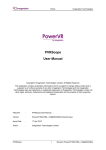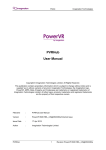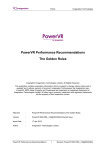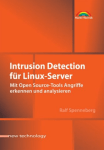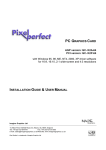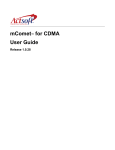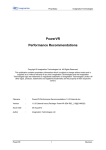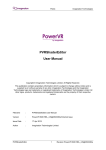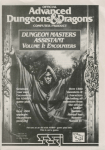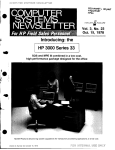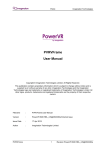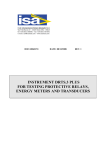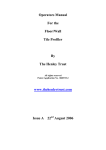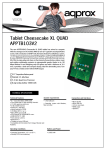Download PVRTune User Manual Developer
Transcript
Public Imagination Technologies PVRTune User Manual Copyright © Imagination Technologies Limited. All Rights Reserved. This publication contains proprietary information which is subject to change without notice and is supplied 'as is' without warranty of any kind. Imagination Technologies and the Imagination Technologies logo are trademarks or registered trademarks of Imagination Technologies Limited. All other logos, products, trademarks and registered trademarks are the property of their respective owners. Filename : PVRTune.User Manual Version : PowerVR SDK REL_3.5@3649239a External Issue Issue Date : 22 Jul 2015 Author : Imagination Technologies Limited PVRTune 1 Revision PowerVR SDK REL_3.5@3649239a Imagination Technologies Public Contents 1. Introduction ................................................................................................................................. 5 1.1. Document Overview ........................................................................................................... 5 1.2. Software Overview.............................................................................................................. 5 2. PVRPerfServer ............................................................................................................................ 7 2.1. Overview ............................................................................................................................. 7 2.2. Requirements ..................................................................................................................... 7 2.3. Installation ........................................................................................................................... 7 2.3.1. Package Installation ................................................................................................. 7 2.3.2. Android ..................................................................................................................... 7 2.3.3. Linux ......................................................................................................................... 7 2.3.4. Neutrino and Windows ............................................................................................. 7 2.4. Driver Compatibility............................................................................................................. 7 2.4.1. Compatible DDK Ranges ......................................................................................... 7 2.5. Usage ................................................................................................................................. 8 2.5.1. Android ..................................................................................................................... 8 2.5.2. Linux ......................................................................................................................... 8 2.5.3. Neutrino and Windows ............................................................................................. 8 2.5.4. Command-Line Options ........................................................................................... 8 2.5.5. Run-Time Options .................................................................................................... 8 3. PVRTune GUI .............................................................................................................................10 3.1. The Basics ........................................................................................................................10 3.1.1. Overview.................................................................................................................10 3.1.2. Installation ..............................................................................................................10 3.1.3. User Interface Layout .............................................................................................10 3.1.4. Getting Started with Analysing an Application .......................................................11 3.2. Menu Bar ..........................................................................................................................12 3.2.1. File Menu ................................................................................................................12 3.2.2. Edit Menu ...............................................................................................................13 3.2.3. View Menu ..............................................................................................................14 3.2.4. Connection Menu ...................................................................................................16 3.2.5. Help Menu ..............................................................................................................16 3.3. Connection Management .................................................................................................18 3.3.1. Connect to a Target Device....................................................................................18 3.3.2. Connect Using a Broadcasting Server ...................................................................18 3.3.3. Connect via Localhost ............................................................................................18 3.3.4. Connect Using a Recent Connection .....................................................................19 3.3.5. Connect Using a Saved File ...................................................................................19 3.3.6. Alternative Ways of Connecting .............................................................................19 3.3.7. View Connection Status .........................................................................................19 3.3.8. View and Modify PVRPerfServer Settings .............................................................20 3.3.9. Close a Connection ................................................................................................21 3.4. Monitor Window: Performance at a Glance ......................................................................22 3.5. Working with the Timeline ................................................................................................23 3.5.1. Using the Graph View ............................................................................................23 3.5.2. Timing Data ............................................................................................................26 3.5.3. Event List ................................................................................................................28 3.6. Working with Counters .....................................................................................................32 3.6.1. Select Columns to Display .....................................................................................32 3.6.2. Add a Counter to the Graph View ..........................................................................34 3.6.3. Remove a Counter from the Graph View ...............................................................35 3.6.4. Counter Legend in the Timeline Area ....................................................................35 3.6.5. PVRTrace Software Counters ................................................................................36 3.6.6. Counter Properties .................................................................................................37 3.7. Process ID (PID) Window .................................................................................................39 3.8. Remote Editor Window .....................................................................................................39 Revision PowerVR SDK REL_3.5@3649239a 2 User Manual Public Imagination Technologies 3.9. Renderstate Override Window .........................................................................................39 3.9.1. OpenGL ES Timing Data........................................................................................41 3.10. Find Window .....................................................................................................................41 4. Identifying Bottlenecks ............................................................................................................42 4.1. CPU Limited......................................................................................................................42 4.2. Vertex Limited ...................................................................................................................43 4.3. V-Sync Limited..................................................................................................................43 4.4. Fragment Limited ..............................................................................................................44 4.5. Bandwidth Limited ............................................................................................................44 5. Contact Details ..........................................................................................................................45 Appendix A. Hardware Terms: Quick Reference .......................................................................46 List of Figures Figure 1. Structure of PVRTune .............................................................................................................. 6 Figure 2. General layout of PVRTune GUI ........................................................................................... 11 Figure 3. File menu ............................................................................................................................... 13 Figure 4. Edit menu ............................................................................................................................... 13 Figure 5. Preferences dialog box .......................................................................................................... 14 Figure 6. View menu ............................................................................................................................. 15 Figure 7. Connection menu ................................................................................................................... 16 Figure 8. Help menu .............................................................................................................................. 17 Figure 9. Connection interface displayed after launching PVRTune GUI ............................................. 18 Figure 10. PVRPerfServer Details dialog box ....................................................................................... 20 Figure 11. Monitor window .................................................................................................................... 22 Figure 12. Graphical representation of captured data .......................................................................... 23 Figure 13. Example of Tiler and Renderer timing data ......................................................................... 26 Figure 14. Transfer tasks ...................................................................................................................... 27 Figure 15. Example of task colour coding ............................................................................................. 28 Figure 16. Example of driver timing data .............................................................................................. 28 Figure 17. Example of active counters changed ................................................................................... 29 Figure 18. Example of event ordinal reset ............................................................................................ 29 Figure 19. Example of custom mark ..................................................................................................... 30 Figure 20. Example of power-off period ................................................................................................ 30 Figure 21. Example of data loss period ................................................................................................ 31 Figure 22. Example of hardware reset period ....................................................................................... 31 Figure 23. Example of SPM mode ........................................................................................................ 31 Figure 24. Counter Table window ......................................................................................................... 32 Figure 25. Dialog box for selecting and deselecting columns ............................................................... 33 Figure 26. Adding a counter to a graph view ........................................................................................ 34 Figure 27. Creating a new graph by adding a counter to a graph placeholder ..................................... 34 Figure 28. Counter Properties window .................................................................................................. 38 Figure 29. PID window .......................................................................................................................... 39 Figure 30. Remote Editor window ......................................................................................................... 39 Figure 31. Renderstate Override window ............................................................................................. 40 Figure 32. Find window ......................................................................................................................... 41 Figure 33. Identifying CPU limited applications .................................................................................... 42 Figure 34. Identifying vertex limited applications .................................................................................. 43 PVRTune 3 Revision PowerVR SDK REL_3.5@3649239a Imagination Technologies Public Figure 35. Identifying fragment limited applications .............................................................................. 44 List of Tables Table 1. Command-line options .............................................................................................................. 8 Table 2. Run-time hotkeys ...................................................................................................................... 9 Table 3. Connection status information in the Status bar ..................................................................... 19 Table 4. Information captured in the PVRPerfServer Details dialog box .............................................. 20 Table 5. Summary of columns and their description ............................................................................. 33 Table 6. List of PVRTrace software counters ....................................................................................... 36 Table 7. Explanation of renderstate override options ........................................................................... 40 Table 8. Quick reference of hardware terms......................................................................................... 46 Revision PowerVR SDK REL_3.5@3649239a 4 User Manual Public Imagination Technologies 1. Introduction 1.1. Document Overview The purpose of this document is to serve as a complete user manual for PVRTune and PVRPerfServer. It includes installation instructions, functionality explanations and useful tips on how to make the most out of the applications. 1.2. Software Overview PVRTune is a performance analysis tool for the PowerVR graphics cores. It uses driver level counters and hardware registers to provide real-time data on the performance of an application running on a PowerVR graphics core. PVRTune receives performance data from either PVRPerfServer or PVRHub running on the target device. Figure 1 illustrates the conceptual structure of PVRTune in relationship to the interactions taking place at the client software, device software and device hardware levels. The following concepts are relevant to the figure: PVRPerfServer: This is an application which runs on the target device and reads counters and registers from the driver (and also, optionally, from any application which uses the PVRScope library) and either saves the data to a PVRTUNE file or transmits the data to PVRTune over a network. PVRHub: This is an application which runs on Android or Linux and allows an instance of PVRPerfServer or PVRTrace to run on the target device. For the remainder of this document, all PVRPerfServer functionality can be accomplished using PVRHub, unless otherwise stated. PVRScope: This is a performance analysis library that retrieves graphics core counter data and works alongside PVRTune to augment it with custom markers and counters. PVRTune: This is the client-side element of the combined package. It provides a graphical representation of the real-time information being sent by PVRPerfServer, as well as providing a means to save and load PVRTUNE files. Note: On Android, PVRHub is an application that has a user interface. On Linux, it is a set of folders and scripts. For more information regarding PVRHub, see the “PVRHub User Manual”. PVRTune 5 Revision PowerVR SDK REL_3.5@3649239a Imagination Technologies Public Client Software PVRTune Network Connection Device Software PVRPerfServer of PVRHub PVRScope Enabled Application PVRScope PVRScopeServices (Device Driver) PVRTune Device Hardware Figure 1. Structure of PVRTune Revision PowerVR SDK REL_3.5@3649239a 6 User Manual Public Imagination Technologies 2. PVRPerfServer 2.1. Overview PVRPerfServer is a console application for Android, Linux, Neutrino and Windows. Its purpose is to read counters and registers from the PowerVR hardware on a device and either save the data to a PVRTUNE file or transmit that data to PVRTune over a network. 2.2. Requirements In order for PVRPerfServer to function correctly, the driver must have performance profiling enabled. In many cases, as the overhead is so small, this functionality is available by default. This can be checked by confirming the existence of PVRScopeServices.dll, libPVRScopeServices.so or an equivalent. If PVRPerfServer fails to initialise, it is likely that performance profiling support has been removed from the device drivers. 2.3. Installation 2.3.1. Package Installation PVRTrace can be installed from the PowerVR SDK installer: 1. 2. 3. Navigate to the PowerVR Insider SDK webpage (powervrinsider.com) and download the SDK. Launch the installer and follow the on-screen instructions. Once the SDK has been successfully installed, PVRPerfServer can be found within the PVRTune folder in the install directory: <InstallDir>\PVRTuneDeveloper\PVRPerfServer\<PLATFORM>\ 2.3.2. Android PVRPerfServer functionality is obtained by installing PVRHub for Android. To install this application, run adb install PVRHub.apk on the local machine. 2.3.3. Linux With the package successfully installed, copy the PVRHub folder to the target device and follow the instructions found in the “PVRHub User Manual”. 2.3.4. Neutrino and Windows With the package successfully installed, copy the PVRPerfServer binary to the target device. 2.4. Driver Compatibility 2.4.1. Compatible DDK Ranges On PowerVR hardware devices, PVRPerfServer is limited to supporting the following driver versions: 1.3.13.1589 onwards. 1.4.14.593 onwards. PVRTune 7 Revision PowerVR SDK REL_3.5@3649239a Imagination Technologies 2.5. Public Usage 2.5.1. Android With the Android APK installed, open the application menu and run PVRHub. 2.5.2. Linux From a command-line interface run pvr_profile <binary>, where <binary> is the desired application for profiling. 2.5.3. Neutrino and Windows From a command-line interface run the PVRPerfServer executable. Note: Only one client at a time may be connected to an instance of PVRPerfServer. 2.5.4. Command-Line Options PVRPerfServer supports several command-line options as identified next. Table 1. Command-line options Option Effect -h Show help text. /? Show help text. --disable-hwperf Disables the use of PVRScope‟s hardware performance functionality. --group=N On start-up, switch the hardware to the specified counter group number. --port=N Network port to use. Default is 6520. --sendto=”myfile” Instead of using the network, record data directly to the specified file. --t=N Time, in milliseconds, between counter updates. The default value is 2. This value can be increased to reduce the CPU usage of PVRPerfServer. --c=N Time, in milliseconds, between CPU Load updates. The default value is 200. --pid Gather data for CPU usage, memory usage and PID executable name of relevant programs. --pid=N,M Gather data for CPU usage, memory usage and PID executable name of relevant programs. In addition, track the specified PIDs. --periodic=1/0 Enables/disables periodic timing tasks (for use when recording to a file). --graphics=1/0 Enables/disables graphics timing tasks (for use when recording to a file). --qat=N Commands PVRPerfServer to auto-quit after a specified number of seconds 2.5.5. Run-Time Options PVRPerfServer supports several key-presses at run-time. This is summarised in Table 2. Revision PowerVR SDK REL_3.5@3649239a 8 User Manual Public Imagination Technologies Table 2. Run-time hotkeys Key Effect H Show help text. M Send a mark. Useful for placing simple markers into the data stream, annotated with a number that increments for each mark. Q Quit PVRPerfServer. PVRTune 9 Revision PowerVR SDK REL_3.5@3649239a Imagination Technologies Public 3. PVRTune GUI 3.1. The Basics 3.1.1. Overview The PVRTune GUI captures and presents the real-time information sent by PVRPerfServer and also provides a means of saving and loading PVRTUNE files for analysis. 3.1.2. Installation PVRTune GUI can be installed from the PowerVR SDK installer: 1. 2. 3. Navigate to the PowerVR Insider SDK webpage (powervrinsider.com) and download the SDK. Launch the installer and follow the on-screen instructions. Once the SDK has been successfully installed, PVRTune GUI will be available in: <InstallDir>\PVRTuneDeveloper\PVRTune\<PLATFORM>\ 3.1.3. User Interface Layout The default analysis interface is displayed after a connection has been established or after a PVRTUNE file has been loaded (see Section 3.3 for more information on how to connect). The PVRTune GUI displays a large amount of information (Figure 2), split into the following sections: Menu bar (Figure 2a): The section enables access to several options related to file, edit, view, connection and help. Timeline area (Figure 2b): This section displays counter data as a function of time. Counter Table window (Figure 2c): This section lists all the hardware and software counters that are in use. Counter Properties window (Figure 2d): This section is used to view counter-specific information when a counter is chosen from the Counter Table. Find window (Figure 2e): This section allows the user to search for a variety of items, such as counters and markers. Renderstate Override window (Figure 2f): This section allows the user to interact with the renderstate of the target device. Monitor window (Figure 2g): This section displays various loads recorded by the utility. Remote Editor window (Figure 2h): This section details data from PVRScope. PID window (Figure 2i): This section displays the connections being used in the recording. Status bar (Figure 2j): This section provides general information pertaining to the running of PVRTune. Revision PowerVR SDK REL_3.5@3649239a 10 User Manual Public (a) Imagination Technologies (b) (e) (c) (f) (i) (d) (g) (h) (j) Figure 2. General layout of PVRTune GUI 3.1.4. Getting Started with Analysing an Application There are several benefits to using PVRTune to analyse an application, and the achievement of effective analysis is largely driven by the ability to understand how to identify application bottlenecks (see Section 4). By analysing an application, it is possible to obtain improved frame rate to increase user enjoyment and application responsiveness. Furthermore, using PVRTune allows reduced render time to be obtained without increased frame rate in order to gain more idle time, thereby saving power. Analysing using PVRTune can also help increase visual quality without sacrificing frame rate. There are two main approaches to analysing an application in PVRTune, namely through connected analysis (which displays real-time data) and offline analysis (from a saved PVRTUNE file). These main steps involved in these two approaches are summarised next. Connected Analysis Connected analysis is the assessment of real-time data from a target device connected using PVRPerfServer. The core steps to performing a connected analysis are as follows: 1. 2. 3. 4. 5. 6. 7. Ensure that the target device is using the PowerVR device drivers. Boot the target device. Install PVRPerfServer on the target device. If necessary, initialise the PowerVR device drivers. Run PVRPerfServer. If successful PVRPerfServer outputs the server name, IP address and port number. Run PVRTune GUI on the host machine. It is important that both PVRTune and PVRPerfServer have matching versions. If PVRPerfServer is on the same subnet as PVRTune, the target device will be broadcast in PVRTune GUI (see Section 3.3.2). If this is not the case, then manually enter the IP address of the server (see Section 3.3.1). PVRTune 11 Revision PowerVR SDK REL_3.5@3649239a Imagination Technologies 8. 9. 10. Public Once successfully connected, identify the bottleneck in the application by analysing the output of PVRTune (for more information, see Section 4). Attempt to resolve the bottleneck. For more information on optimization techniques, see the document entitled “PowerVR Performance Recommendations”. Repeat the necessary steps with the newly optimized application until performance is at the required level or no further bottlenecks can be identified. Offline Analysis It is possible to analyse an application without being directly connected to PVRPerfServer. This requires a PVRTUNE file of the target application to have been created prior to analysis. This approach is particularly useful when large amounts of data are being lost due to network load or high CPU usage on the client machine. A PVRTUNE file can be created either through the use of the --sendto= command-line parameter for PVRPerfServer, or by saving the file of an existing tune using PVRTune GUI (see Section “Save a File”). Note: PVRPerfServer only saves counter data for a single counter group when using the --sendto= parameter. By default the group is set to zero but this can be changed using the --group= command-line parameter. With a PVRTUNE file created and copied across to an accessible location, perform the following steps: 1. 2. 3. 4. 5. 6. Identify the version of PVRTune and PVRPerfServer used to create the file. Run the version of PVRTune that matches the identified PVRPerfServer version. Open the file in PVRTune GUI (see Section 3.3.5). PVRTune GUI will then display the tuning data. Identify the bottleneck. Attempt to resolve the bottleneck. For more information on optimization techniques, see the document entitled “PowerVR Performance Recommendations”. Repeat the necessary steps with the newly optimized application until performance is at the required level or no further bottlenecks can be identified. 3.2. 3.2.1. Menu Bar File Menu Figure 3 illustrates the File menu which provides options for opening and saving files, managing tabs and exiting PVRTune GUI. Revision PowerVR SDK REL_3.5@3649239a 12 User Manual Public Imagination Technologies Figure 3. File menu Open a New Tab To open a new tab in the Timeline area, click File -> New Tab (Figure 3). This is a useful feature that allows multiple graph views to be opened at the same time. Close a Currently Selected Tab Closing the currently selected tab in the Timeline area can be achieved by clicking File -> Close Tab (Figure 3). Rename a Tab Tabs present in the Timeline area can be renamed on-demand. To rename a tab, select it and click File -> Rename Tab (Figure 3). Open a File To open a PVRTUNE file, click File -> Open (Figure 3). This will open a dialog box for browsing to the required file. Save a File To save a PVRTUNE file, click File -> Save (Figure 3). This will open a dialog box in which the name of the file can be input and the file saved. Exit PVRTune To close PVRTune GUI, click File -> Exit (Figure 3). 3.2.2. Edit Menu Figure 4 illustrates the Edit menu which provides options for editing user preferences. Figure 4. Edit menu Preferences User preferences are set by clicking Edit -> Preferences… in the Menu bar. This opens the Preferences dialog box (Figure 5) which displays various options to enable the customization of PVRTune GUI. The Preferences dialog box contains several options: Background: This option is available under the Graph section of the Preferences dialog box and allows the background colour of graph in the Timeline area to be changed from the default setting to either light or dark, in order to make it easier to depict lines. PVRTune 13 Revision PowerVR SDK REL_3.5@3649239a Imagination Technologies Public Draw Marks across all timelines: This option is turned off by default but can be toggled if necessary to show up marks in the Timeline area. Hide empty timelines: Toggle this option to show or hide empty timelines in the Timeline area. Zoom control: invert mouse wheel: This option is available under the Graph section of the Preferences dialog box. The mouse wheel can be used to zoom in and out of a graph in the Timeline area. With the option unchecked, i.e., set to default, scrolling down zooms into the area while scrolling up zooms out of it. This default setting can be inverted by ticking the Zoom control: invert mouse wheel checkbox. Integrate connection form: This option is available under the User Interface section of the Preferences dialog box. Unchecking this option enables the user to make the connection form (see Section 3.3) a pop up window. Hide unnecessary tabs: This option is available under the User Interface section of the Preferences dialog box and, if unchecked, an individual tab is assigned for the connection form in the Timeline area. This facilitates quick access to the connection form after a connection is made or with a file loaded. Figure 5. Preferences dialog box 3.2.3. View Menu Figure 6 illustrates the View menu. The menu provides options for finding information as well as showing or hiding the various windows present in the PVRTune GUI, thereby allowing for workspace customization. Note: The workspace can also be customized by dragging and dropping the individual dockable sections to either the right or left hand sides of the interface or as standalone windows. Revision PowerVR SDK REL_3.5@3649239a 14 User Manual Public Imagination Technologies Figure 6. View menu Find To initiate a search, click View -> Find… (Figure 6). This will open the Find window or jump to it for carrying subsequent steps in searching for information (see Section 3.9.1). Use Default Counter Y-Axis Scales Selecting the Use Default Counter Y-Axis Scales option (Figure 6) informs PVRTune to use its default Y-axis values for counters. The information appears in the Y Axis field in the Counter Properties window. Insert New Graph Pane This option (Figure 6) allows adding a new graph within the selected view in the Timeline area. Restore Default Graph Panes This option (Figure 6) causes only the timing data to display in the Timeline area, hiding additional graph panes. The timing data then occupies the full space within the Timeline area. Toggle Single Window Layout To switch to a single window layout for the graph displayed in the Timeline area (see Section 3.5.1), toggle the option View -> Single window Layout (Figure 6). Toggle Split Window Layout To switch to a split window layout for the graph displayed in the Timeline area, toggle View -> Split Window Layout (Figure 6). This organises two graph views within the same tab. Customize Counter Table Columns To customize the display of columns in the Counter Table window (see Section 3.6.1), click View -> Select Columns… (Figure 6). This will open a dialog box to allow the selection of the required columns (see Section 3.6.1). PVRTune 15 Revision PowerVR SDK REL_3.5@3649239a Imagination Technologies Public Refresh PVRTune GUI To refresh PVRTune GUI, click View -> Refresh (Figure 6). Show or Hide Counter Table Window To show or hide the Counter Table window, toggle View -> Counter Table (Figure 6). Show or Hide Counter Properties Window To show or hide the Counter Properties window (see Section 3.6.6), toggle View -> Counter Properties (Figure 6). Show or Hide Renderstate Override Window To show or hide the Renderstate Override window (see Section 3.9), toggle View -> Renderstate Override (Figure 6). Show or Hide PID Window To show or hide the PID window (see Section 3.7), toggle View -> PID (Figure 6). Show or Hide Find Window To show or hide the Find window (see Section 3.9.1), toggle View -> Search (Figure 6). How or Hide Remote Editor Window To show or hide the Remote Editor window (see Section 3.8), toggle View -> Remote Editor (Figure 6). Show or Hide Monitor Window To show or hide the Monitor window (see Section 3.4), toggle View -> Monitor (Figure 6). 3.2.4. Connection Menu Figure 7 illustrates the Connection menu which is used for connection management purposes. A number of options are available from this menu and these are covered in further detail in Section 3.3. Figure 7. Connection menu 3.2.5. Help Menu The Help menu is opened by selecting the appropriate option from the Menu bar (Figure 8). It provides options for accessing PVRTune help assets, sending feedback, viewing general PVRTune release information and checking for software updates. Revision PowerVR SDK REL_3.5@3649239a 16 User Manual Public Imagination Technologies Figure 8. Help menu View PVRTune User Manual To view the “PVRTune User Manual”, click Help -> PVRTune Help (Figure 8). Submit Feedback To provide feedback, click Help -> Feedback… This will open a dialog box where instructions are displayed on how to post feedback and request for support (Figure 8). Check for Updates As of SDK release 3.0, PVRTune is able to auto-update. However, to force-check for software updates, click Help -> Check for Updates (Figure 8). About PVRTune To view basic information about PVRTune release information such as versioning and contact details, click Help -> About… (Figure 8). PVRTune 17 Revision PowerVR SDK REL_3.5@3649239a Imagination Technologies 3.3. Public Connection Management Establishing a connection is a fundamental step prior to being able to visualize hardware performance data in PVRTune GUI. The connection management capability of PVRTune provides a range of options to facilitate the task of connecting. Upon launching PVRTune, the connection form is displayed as shown in Figure 9. Notice that the various windows and options used for analysis purposes are disabled at that point, until a valid connection is made or a PVRTUNE file is loaded. (a) (b) (c) Figure 9. Connection interface displayed after launching PVRTune GUI Note: The connection form can be customized as a pop window and can also be assigned an individual tab in the Timeline area (see Section “Preferences”). 3.3.1. Connect to a Target Device To connect to a target device, perform the following steps: 1. 2. Enter an IP address or IP resolvable name of the target device into the Connect to: box (Figure 9a). Click the Go button to start the connection. If an instance of PVRPerfServer is found, PVRTune will connect to the target device. 3.3.2. Connect Using a Broadcasting Server When launched, and periodically after launch, PVRPerfServer broadcasts its existence to the subnet to which it is connected. PVRTune GUI lists all the instances of PVRPerfServer broadcasting on the user‟s subnet in the area of the connection form identified in Figure 9b. Connection can be established by selecting the desired target IP address in the list. 3.3.3. Connect via Localhost Connecting via localhost implies the establishment of a connection between PVRTune and an instance of PVRPerfServer running on the same device that PVRTune is running on. The option for connecting via localhost will be displayed in the connection form if it can be reached. Revision PowerVR SDK REL_3.5@3649239a 18 User Manual Public Imagination Technologies Note: PVRTune uses TCP port 6520 to send data to and from Android devices. In order to setup a localhost connection, adb forward must be used to forward TCP data across the USB connection. To run adb forward, enter the following command in a command prompt: adb forward tcp:6520 tcp:6520 3.3.4. Connect Using a Recent Connection Recently used connections and PVRTUNE file paths are listed in the area of the connection form identified in Figure 9c. This area also lists recently accessed PVRTUNE files, if any. To connect using a recently used connection, select the desired connection from the list. 3.3.5. Connect Using a Saved File A saved PVRTUNE file can be loaded by clicking File -> Open and browsing to the required file (see Section “Open a File”). 3.3.6. Alternative Ways of Connecting It is possible, using the Connection menu (see Figure 7), to control some aspects of connection management. These are: Establish a new connection: Select the New option in the Connection menu to open a dialog box for inputting the IP address or IP resolvable name. This is essentially the same procedure discussed in Section 3.3.1. Connect via localhost: Select the localhost option in the Connection menu to connect via localhost. This is essentially the same procedure discussed in Section 3.3.3. Connect using a recent connection: Select the Recent Connections option in the Connection menu to view a list of previously accessed connections and choose the desired connection from the list. This is essentially the same procedure discussed in Section 3.3.4. 3.3.7. View Connection Status Data related to the connection status of PVRTune is displayed in the Status bar area of PVRTune GUI (see Figure 2j). Table 3 lists the details of the data that is displayed, from left to right, in the Status bar. An example of connection status data is: Receiving 11.2640s (56607, 4922.58ps 0.000sp); 337.9KB/s; 0.7%; 0 Table 3. Connection status information in the Status bar Data Description Status This indicates the current status of PVRTune. The options available are: Connecting, Receiving and Disconnected. Time This indicates for how long PVRTune has been receiving data or was connected (if the current status is disconnected). Count The number of times PVRTune has performed an action related to its current status (e.g., if PVRTune is receiving data, then the count indicates the number of times it has received data from PVRPerfServer). Count per second The rate at which the count value moves per second. Gap The average time period between actions as measured by the count value. Receive rate The rate at which PVRTune is receiving data. PVRTune 19 Revision PowerVR SDK REL_3.5@3649239a Imagination Technologies Public Data Description DC% The percentage progress towards automatic disconnect due to memory usage (after PVRTune has recorded 1GB of data, it disconnects from PVRPerfServer). Group The currently active counter group. 3.3.8. View and Modify PVRPerfServer Settings Figure 10 illustrates the PVRPerfServer Details dialog box, which is accessed by selecting Connection -> PVRPerfServer -> Details from the Menu bar. The dialog box can be used to view the current PVRPerfServer information and modify certain settings. In other words, when PVRTune is connected with PVRPerfServer, the dialog box allows PVRTune to remotely control the counter groups that are currently active on PVRPerfServer. This in turn then activates or deactivates certain counters on the PowerVR hardware. Figure 10. PVRPerfServer Details dialog box Note: Any warning encountered in the running of PVRPerfServer and PVRTune is also captured in the dialog box. Table 4 provides a description of the fields present in the PVRPerfServer Details dialog box. Table 4. Information captured in the PVRPerfServer Details dialog box Field Description Group Active counter group on PVRPerfServer. Different counter groups can be selected, as appropriate, to change their settings. Sample Time (ms) Time, in milliseconds, between the hardware samples taken by PVRPerfServer. CPU Load sample time (ms) Time, in milliseconds, between the CPU Load samples taken by PVRPerfServer. Revision PowerVR SDK REL_3.5@3649239a 20 User Manual Public Imagination Technologies Field Description Periodic Data Enable When this option is ticked, PVRTune receives counter updates much quicker than otherwise. This option is enabled by default. Timing Data Enable When this option is ticked, PVRTune receives Tiler or Renderer timing data. This option is enabled by default. Operating System Name and version details of the operating system of the target device. Driver name Version of the PowerVR driver being used. Device Variant Variant-specific details of the device. Device Series Series-specific details of the device. Server Description PVRPerfServer name and version number. Server Build Release and build version of PVRPerfServer. Server Connection Time (local) The local time at which PVRPerfServer became connected. Server Connection Time (UTC) The Coordinated Universal Time (UTC) at which PVRPerfServer became connected. Note: Clicking the Connection -> PVRPerfServer -> Send Quit Message option sends a message to PVRPerfServer requesting the process to exit. 3.3.9. Close a Connection A connection can be closed on demand when it is no longer required. To close a connection, click Connection -> Close. If real-time analysis is being performed, then clicking the Close option once will first stop connection to PVRPerfServer, allowing the data to be saved as a PVRTUNE file or for continuing the analysis as-is. Clicking the Close option a second time will exit the analysis and return the user to the connection form. On the other hand, in the case of offline analysis from a previously saved PVRTUNE file, clicking the Close option simply exits the analysis and returns the user to the connection form. PVRTune 21 Revision PowerVR SDK REL_3.5@3649239a Imagination Technologies 3.4. Public Monitor Window: Performance at a Glance PVRTune GUI comes with a monitoring functionality which allows the user to view a high level overview of graphics core workloads, thereby giving insight on how to isolate application bottlenecks. The Monitor window displays and categorises the various loads being tracked by PVRTune, as shown in Figure 11. The dropdown box for the time period (Figure 11a) facilitates choosing over how long the loads should be averaged. In the example, this time period is set to the default 0.5s value. Note: Further information on how to analyse bottlenecks can be found in Section 4. (a) Figure 11. Monitor window Revision PowerVR SDK REL_3.5@3649239a 22 User Manual Public 3.5. Imagination Technologies Working with the Timeline The captured data is plotted in the Timeline area of PVRTune GUI and displayed as a graphical representation in order to facilitate analysis. Figure 12 illustrates an example of static data displayed after a saved PVRTUNE file is opened, using the default graph view. The information is split into three distinct graphs, which capture render timing data and counter data. Note: If the analysis were based on real-time profiling, which is dynamic in nature, the displayed timing data would appear to be continuously changing with time. (f) (d) (e) (b) (c) (a) Figure 12. Graphical representation of captured data 3.5.1. Using the Graph View A number of user actions can be performed when interacting with the graph view. These are documented next. Zoom in and out of a Graph Zooming in and out of a graph is a useful feature for being able to visualize details of the captured data as well as to have a more general perspective of the trend of the data as a whole. One method of zooming in and out is to use the scroll button of a mouse in the graph view. Alternatively, a zoom value can be specified in the Zoom field (Figure 12a). The lower the zoom value, the bigger the magnification and vice versa. PVRTune 23 Revision PowerVR SDK REL_3.5@3649239a Imagination Technologies Public Note: By default, scrolling up decreases the size of the graph whereas scrolling down zooms into it. The mouse scroll order can be inverted by using the Preferences dialog box (see Section “Preferences”). Smooth out Counters Counters displayed in the timeline can be smoothed out by specifying a value in the Smooth field (Figure 12b). The maximum value is 80. Increasing the value will smooth out the counter and the counter plots become easier to interpret. View Captured Data over the Entire Time Period To adjust the graph view such that the captured data is displayed for the entire time period, perform the following: 1. Right-click a graph in the Timeline area. This will open an action menu. 2. From the menu, select the option called View Selection/All. Note: The value of the total time period is specified at the bottom of the graph view (Figure 12c). View the Start of the Captured Data To adjust the graph view such that the start of the captured data is shown, perform the following: 1. Right-click a graph in the Timeline area. This will open an action menu. 2. From the menu, select the option called View Earliest. View the End of the Captured Data To adjust the graph view such that the end of the captured data is shown, perform the following: 1. Right-click a graph in the Timeline area. This will open an action menu. 2. From the menu, select the option called View Latest. Select a Time Range A specific region can be selected on a graph during analysis. This can be achieved by using the Ctrl key while left clicking and dragging on a graph. To deselect an already selected region, press Ctrl and left click anywhere on the graph. The selection of a time range is relevant when viewing averaged values over the range (see Section 3.6.1). Change the Graph View Layout The layout of the graph view can be quickly changed to a single or split view layout. This is carried out by using the Single View Layout and Split View Layout options from the View menu (see Section 0). Change the Graph Rendering Options During an analysis task, certain types of data can be shown or hidden on demand in the graph view. To change the data render options, perform the following: 1. 2. Right-click a graph in the Timeline area, where the change needs to be made. This will open an action menu. From the menu, select or remove the options Render 25%, 50%, 75% Quarters, Render Timing Data or Render Marks, as appropriate. The change will be reflected on the graph. Revision PowerVR SDK REL_3.5@3649239a 24 User Manual Public Imagination Technologies Restore the Default Graph View After changes to the graph view have been made it is possible to revert to default settings, if required. To achieve this, perform the following: 1. Right-click a graph in the Timeline area. This will open an action menu. 2. Select the option Restore Default View. Close a Graph in a Multi-Graph View In a multi-graph view, as in Figure 12, it is possible to close one of the graphs by clicking its corresponding button to close it (Figure 12d). To display the graph again, restore the graph view to default. Add and Remove Tabs Tabs displaying graphs can be added and removed on demand. This procedure is highlighted in Section 3.2.1. Save a Graph as an Image PVRTune GUI comes with options to allow graphs to be saved as images. There are different modes for saving a graph as an image and the procedure is next highlighted: 1. Right-click a graph in the Timeline area. This will open an action menu. 2. From the menu, select the desired save settings which are one of Save Image with HUD (saves „foreground‟ content when mouse hovering over a graph), Save Image (saves image in the same location as the binary) and Save Image To… (saves image to a user-defined location). Pause the View during Connected Analysis During real-time profiling, the graph view continuously changes with time since the collected data is dynamic. To pause the view at a given time, perform the following steps: 1. Right-click a graph in the Timeline area. This will open an action menu. 2. Select the option Pause View. Add and Remove Counters to Graph Counters can be added on demand to the timeline by selecting them from the Counter Table window and dragging them to the graph. This is covered in more detail in Section 3.6.2. Note: Some counters, when added to a graph view, may not be immediately visible as a result of very low or very high Y-axis values. This can be overcome by adjusting the Y-axis scaling of the counter (see Section “Change the Y-Axis Scaling of a Counter”). View Events Several events (also known as marks) are displayed in the timeline in addition to all of the other information. These marks are signified by bars running from the top of the graph to the bottom (Figure 12e). A full list of the supported events can be found in Section 3.5.3. Use the Counter Legend The Timeline area also contains a Counter Legend section which can be used for several purposes (Figure 12f). See Section 3.6.4 for more details. PVRTune 25 Revision PowerVR SDK REL_3.5@3649239a Imagination Technologies 3.5.2. Public Timing Data Timing data can be made visible on a graph by choosing the Render Timing Data option from the action menu displayed when right-clicking the graph (see Section “Change the Graph Rendering Options”). By default, in a multi-graph view (e.g., using default view settings) the timing data is always displayed in the bottommost graph. Figure 13 depicts an example of captured timing data. The timing data is arranged on several timelines, each with its own label. The timeline labelled Tiler represents the Tile Accelerator (TA) core time, which is a measure of the time spent in tiling/culling the frame and running vertex shaders. The timeline labelled Renderer represents Renderer time and is a measure of how much time is spent fetching textures, processing fragment shaders and other fragment processing tasks. These timelines represent the two main stages in the Tile Based Deferred Rendering (TBDR) process. Note: In addition to the Tiler and Renderer timelines, there can also be others depending on the hardware being profiled. A summary of hardware-specific terms is provided in Appendix A. Also consult the “PowerVR Hardware Architecture Guide” for a more detailed understanding of the PowerVR hardware architecture. Each block displayed in the representation of the timing data corresponds to a given task or activity within a frame and is colour coded to make the frame, process ID and render target easily identifiable. In addition to Tiler and Renderer timing data, there can also exist other sets of data for transfer tasks, 2D core time (for chips with dedicated 2D cores), compute time (for PowerVR Series6 onwards) and custom timing data sent using PVRScope. Figure 13. Example of Tiler and Renderer timing data View Details of Timing Data A wealth of information can be gained from the timing data by holding the mouse pointer over a task in the timeline. The information displayed this way details the process ID, the frame number, the total number of tasks on each timeline (such as Tiler and Renderer) that can be attributed to the same frame, the time spent on each task, the time spent processing a set of tasks, and the total time spent processing the frame. Revision PowerVR SDK REL_3.5@3649239a 26 User Manual Public Imagination Technologies Transfer Tasks Transfer tasks represent the time spent processing tasks related to moving large amounts of memory, such as blitting or texture uploading. Figure 14 shows an example where a series of transfer tasks are displayed as timing data. These tasks are depicted as a series of grey blocks with pink tips. Figure 14. Transfer tasks Task Colour Coding The displayed timing data is colour coded for convenience of interpretation. Blocks of the same colour represent a single frame (see Figure 13), where the colours are recycled every sixteen frames. In addition to the general colour of a block, its top and bottom tips are also coloured. The top tips represent the process ID, where different colours indicate different process IDs. On the other hand, the bottom tips represent the render target, where different colours indicate different render targets. Figure 15 provides an example of task colour coding used in the display of timing data. The core colour of a task represents a single frame. Each frame is given a core colour (Figure 15a), an associated process (Figure 15b) and a render target (Figure 15c). Repeated top tip colours refer to the same process ID. In Figure 15 the tasks were generated by one process, which is indicated through the use of a single colour (pale blue) across the top tips. Repeated bottom tip colours refer to the same render targets. In the example, three render targets are present and these are indicated by the three colours used for the bottom tips of the tasks. In double or triple buffered situations the render targets are different for each frame, alternating between each of the back buffer targets. PVRTune 27 Revision PowerVR SDK REL_3.5@3649239a Imagination Technologies Public (b) (a) (c) Figure 15. Example of task colour coding Driver Timing Data Driver timing data becomes relevant when PVRTune is used in combination with PVRTrace. The data is displayed in its own timeline and is represented as a series of tasks labelled with the thread ID that called the driver. An example of driver timing data is provided in Figure 16. Figure 16. Example of driver timing data Note: By default, only the most expensive calls are displayed, e.g., glDrawElements, glReadPixels, shader compilation and texture uploads. For a more verbose output, open PVRHub, select Options and set API Function Timing Events to Verbose. Warning: Setting API Function Timing Events to Verbose may affect performance. 3.5.3. Event List Active Counters Changed This event represents the point at which the active counter group has been changed using some custom hardware counter group . The event appears as a vertical grey line (Figure 17). Revision PowerVR SDK REL_3.5@3649239a 28 User Manual Public Imagination Technologies Figure 17. Example of active counters changed Event Ordinal Reset This event is usually hidden by active counters changed. The event represents a change in the ordering of the counters or counter sources read by PVRPerfServer and appears as a vertical green line (Figure 18). Figure 18. Example of event ordinal reset Custom Mark Custom marks are marks that have been sent to PVRTune either by a PVRScope enabled application or by pressing the M key in PVRPerfServer. A custom mark appears as a vertical red line (Figure 19). PVRTune 29 Revision PowerVR SDK REL_3.5@3649239a Imagination Technologies Public Figure 19. Example of custom mark Power-off Period Power-off periods are represented by vertical grey blocks in the graph view (Figure 20). These events occur when the hardware has gone to sleep or powering down to save power due to a lack of work. Figure 20. Example of power-off period Data Loss Period A data loss period is one during which PVRTune has lost data that was sent by PVRPerfServer. A data loss period is represented as a vertical green block (Figure 21). There are several possibilities to minimize data loss, such as: Decrease device CPU load. Alter the PVRPerfServer data read rate, using the -c command-line option. There could be congestion on the network the data is being transmitted on. This can be alleviated by using a less congested network or by attempting ad-hoc networking. Save data to a file rather than send it over the network (see Section 2.5.4 for the -sendto= command-line option for PVRPerfServer). Reduce the data quantity. This can be achieved by disabling the –periodic= or –graphics= option via the PVRPerfServer command-line (see Section 2.5.4). Note: PVRPerfServer command-line options can also be set remotely from PVRTune (see Section 2.5.4). Revision PowerVR SDK REL_3.5@3649239a 30 User Manual Public Imagination Technologies Figure 21. Example of data loss period Hardware Reset Period Hardware reset periods occur when the hardware locks up and stops responding, possibly due to firmware or driver error. This usually happens due to the buffer filling up because of the limited storage available. A hardware reset can be identified as a vertical pink block (Figure 22). Figure 22. Example of hardware reset period Smart Parameter Management Mode The Smart Parameter Management (SPM) mode is used to manage parameters when it bufferoverflows. A Renderer task labelled Renderer SPM Task appears when this mode is activated (Figure 23). Figure 23. Example of SPM mode PVRTune 31 Revision PowerVR SDK REL_3.5@3649239a Imagination Technologies 3.6. Public Working with Counters Counter information is listed in the Counter Table window of PVRTune GUI. An example of listed counters is shown in Figure 24. The counters are organised under different headings (e.g., Overview, GPU Advanced, etc.) which can be expanded or collapsed as needed. During connected analysis, the table also displays the counters available within specific counter groups. In the example, the Group dropdown box is disabled (Figure 24a) which is normal during offline analysis. Note: For a full list of default PVRTune counters and their description, refer to the document entitled “PVRTune Counter List and Description”. (a) Figure 24. Counter Table window 3.6.1. Select Columns to Display By default, counter data are tabulated following a similar format as shown in Figure 24. Additional data sets can be customized for display by right-clicking the Counter Table window and choosing the Select Columns… option, as shown in Figure 25. Revision PowerVR SDK REL_3.5@3649239a 32 User Manual Public Imagination Technologies Figure 25. Dialog box for selecting and deselecting columns Table 5 identifies a summary of the additional columns that can be selected and deselected on demand. Table 5. Summary of columns and their description Column Description 0.1s to 32s These values represent time frames. The columns show the average value of counters over the most recent timespan (e.g., the 32s column gives the average over the last 32 seconds). Selected By selecting a time range (see “Select a Time Range”) and using this checkbox, it is possible to view the average over the selected region. Line This column responds to mouse hover. It shows the values of counters at the time associated with the position of the mouse in the graph view. Task This column responds to mouse hover. It shows the average value of counters over the time frame of a single Tiler or Renderer task. Frame This column responds to mouse hover. It shows the average value of given counters over the timeframe of a single frame. View This column responds to mouse hover. It shows the average value of counters over the timeframe of the graph for which the cursor is currently over. Add a Column of Data to the Counter Table An additional column of data can be included in the Counter Table window by selecting it from the participating dialog box (Figure 25). Multiple columns can also be chosen if necessary. Remove a Column of Data from the Counter Table A column of data can be removed from the Counter Table window by selecting it from the participating dialog box (Figure 25). Multiple columns can also be chosen if necessary. PVRTune 33 Revision PowerVR SDK REL_3.5@3649239a Imagination Technologies 3.6.2. Public Add a Counter to the Graph View During connected analysis in PVRTune GUI, counters are updated in real-time and can be plotted against the timeline to give a graphical representation of their change over time. Counters can also be added during offline analysis. To add a counter to a graph view, perform the following steps: 1. Identify the counter that is of interest from the Counter Table window (Figure 24). 2. Drag and drop the counter from the Counter Table window to an existing graph present in the Timeline area. This results in the addition of new plotted data on the graph. Figure 26 shows an example where the Frames per second counter, represented by the line graph, has been added to a graph view with rendered timing data. Figure 26. Adding a counter to a graph view Note: A new graph can be created by dragging and dropping a counter to a graph placeholder available in the Timeline area. A graph placeholder is the narrow area of space located above or below a graph view. An example is shown in Figure 27. (a) Figure 27. Creating a new graph by adding a counter to a graph placeholder Revision PowerVR SDK REL_3.5@3649239a 34 User Manual Public 3.6.3. Imagination Technologies Remove a Counter from the Graph View Counters plotted in the graph view can be removed when they are no longer required. To remove a counter from the graph view, perform the following steps: 1. In the Timeline area, identify the counter that needs to be removed. 2. 3. Click the plot corresponding to the counter. This will highlight the plot. Press Delete to remove the plotted counter data from the graph. The same action can be achieved by right-clicking the counter plot and selecting the Remove Selected Counter option from the action menu. 3.6.4. Counter Legend in the Timeline Area The Counter Legend is located at the right hand side of the Timeline area and lists the counters that are only relevant to the plotted graphs (see Figure 12). A number of options are available to interact with the information displayed in the Counter Legend and these are next discussed. Highlight a Plot Corresponding to a Counter In order to highlight a plot for a counter displayed in the Counter Legend, mouse over the name of the counter. Add a Column of Data to the Counter Legend The data sets displayed in the Counter Legend can be customized on demand. In order to do this, perform the following steps: 1. 2. Right-click anywhere in the Counter Legend. This will open an action menu with several options. Click the Select Column… option. This will open a dialog box to aid the selection of columns (see Figure 25). Note: For further information about the description of the various columns and their functions, see Table 5. 3. 4. Select the desired column to display by using its corresponding checkbox. Multiple columns can be chosen if required. Click the Accept button to apply the changes. The selected column is then added to the Counter Legend. Remove a Counter from the Counter Legend A counter can be removed from the Counter Legend when it is no longer required. To achieve this, click the counter and hit the Delete key. Alternatively, right-clicking the counter will open an action menu from which the Delete Selection option can be chosen. Removing a counter from the Counter Legend also removes its corresponding plot from the graph view. Remove all Counters from the Counter Legend All counters displayed in the Counter Legend can be removed on demand. To achieve this, rightclick anywhere in the Counter Legend to open an action menu from which the Delete All option can be chosen. Removing all counters from the Counter Legend also removes their corresponding plots from the graph view. PVRTune 35 Revision PowerVR SDK REL_3.5@3649239a Imagination Technologies Public Remove a Column of Data from the Counter Legend To remove a column of data from the Counter Legend, perform the following steps: 1. 2. 3. 4. Right-click anywhere in the Counter Legend. This will open an action menu with several options. Click the Select Column… option. This will open a dialog box to aid the deselection of columns (see Figure 25). Uncheck the desired column by using its corresponding checkboxes. Multiple columns can be deselected if required. Click the Accept button to apply the changes. The deselected column is then removed from the Counter Legend. 3.6.5. PVRTrace Software Counters An application is able to send custom software counters to PVRTune via PVRScope. When an application is being profiled specifically by PVRTrace, the corresponding software counters sent to PVRTune using PVRScope provide data on certain statistics within the running application. Enable PVRTrace Software Counters Software counters can be enabled on different operating systems. The approach to enabling these counters on Android, Linux, Neutrino and Windows is as follows: Android: PVRHub should be launched. On the Options screen, ensure that the setting called Enable Software Counters is enabled. PVRTrace Recording Libraries must be installed on the device for this to work. Linux: With PVRHub installed, run pvr_profile <binary> where <binary> is the application that is required to be profiled with software counters active. Neutrino and Windows: In the pvrtraceconfig.json file on the device, ensure that for Profiling the SoftwareCounters and Enabled options are set to true. List of PVRTrace Software Counters Table 6 lists the software counters that are available from the PVRTrace libraries. Table 6. List of PVRTrace software counters Software counters Indexed draw calls Non-indexed draw calls Points no. Line no. (list) Line no. (loop) Line no. (strip) Total line no. Triangle no. (list) Triangle no. (strip) Triangle no. (fan) Total triangle no. Texture uploads Texture modifications Revision PowerVR SDK REL_3.5@3649239a 36 User Manual Public Imagination Technologies Software counters Scissor calls Viewport calls Frame buffer accesses Vertex shader compiles Fragment shader compiles Program links Framebuffer access (bytes) Texture uploads (bytes) Texture modifications (bytes) Buffer object uploads (bytes) Buffer object modifications (bytes) Uniform uploads Context binds Shader proportion: pixel Shader proportion: vertex Shader proportion: compute Vertices per batch Shader slot scheduled count: compute Shader slot scheduled count: pixel Shader slot scheduled count: vertex Shader slot size: pixel Shader slot size: vertex 3.6.6. Counter Properties PVRTune GUI displays of a wide range of information associated with counters. By exploring the properties of a counter, it becomes possible to learn more about, e.g., its description and implications when a high value is recorded, amongst others. The most recently clicked counter is displayed in the Counter Properties window (Figure 28). The window captures some basic details including the counter name, associated colour and the maximum value of the Y-axis to be used on the graph view. PVRTune 37 Revision PowerVR SDK REL_3.5@3649239a Imagination Technologies Public (a) (b) (c) Figure 28. Counter Properties window Change the Colour of a Counter The user is able to customize the colour of a counter on demand by following these steps: 1. Identify the counter that is of interest either from the Counter Table window (see Figure 24) or from the Counter Legend in the Timeline area. 2. Select the counter by clicking it. This will display the properties of the counter in the Counter Properties window (Figure 28). 3. Click the colour icon associated with the counter (Figure 28a). This will open a colour picker from which a suitable substitute colour can be chosen. Select the desired colour from the colour picker. Click OK to complete the procedure. 4. 5. Change the Y-Axis Scaling of a Counter The ability to change the Y-axis scaling of a counter is a handy feature that allows small and large value plots to be scaled for visibility and interpretation. This can be achieved by using the Y Axis field provided in the Counter Properties window (Figure 28b). For particularly large value plots (such as transformations per frame) it is necessary to enter a large scale. On the other hand, for very small value plots (such as frame time) it is necessary to enter a fractional value. View the Description of a Counter Counter description is very important as it helps data interpretation and analysis. To view the description of a counter, perform the following step: 1. Identify the counter that is of interest either from the Counter Table window (see Figure 24) or from the Counter Legend in the Timeline area. 2. Select the counter by clicking it. This will display the properties of the counter in the Counter Properties window (Figure 28). 3. Interpret the detailed information provided (Figure 28c). Revision PowerVR SDK REL_3.5@3649239a 38 User Manual Public 3.7. Imagination Technologies Process ID (PID) Window The PID window in PVRTune GUI displays a list of the individual connections being used in the recording. It only displays the known PIDs relevant to the operation and not all the PIDs running on the system are listed. Figure 29. PID window Note: If no name can be depicted in the Name column, inspect the --pid command-line option from PVRPerfServer (see Section 2.5.4). 3.8. Remote Editor Window This functionality allows for real-time, remote editing of shaders and various numerical value adjustments. PVRScope-enabled applications can register data as being editable or readable by PVRTune. The value of this data can then be passed by PVRScope, via PVRPerfServer, to PVRTune. Any value that has been registered appears in the Remote Editor window in PVRTune GUI (Figure 30). Values can be edited using the options provided in the window and the changes are automatically sent back to the application. Figure 30. Remote Editor window Note: For more information on PVRScope refer to the “PVRScope User Manual”. 3.9. Renderstate Override Window The renderstate override functionality in PVRTune permits the user to remotely control the renderstate of a target device. This provides a useful means of prototyping render changes as well as enabling the quick identification of obscure bottlenecks. The renderstate override functionality is accessible from the Renderstate Override window and in order to use it, PVRTrace profiling mode should be enabled. PVRTune 39 Revision PowerVR SDK REL_3.5@3649239a Imagination Technologies Public Figure 31. Renderstate Override window Table 7 provides a list of the various renderstate override options as well as their description. Table 7. Explanation of renderstate override options Option Description Force zero viewport Modifies the viewport to have zero sized dimensions. Disable blending Disables alpha blending. Force 2x2 textures Forces textures to be 2 pixels by 2 pixels in size. Force flat colour frag shader Forces the fragment shader to output a single colour. Disable stencil test Disables the stencil test. Disable depth test Disables the depth test. Disable scissor test Disables the scissor test. Disable draw calls Disables all glDraw() function calls. Disable flush and finish Disables all glFlush() and glFinish() function calls. Disable texture modifications Disables glTexSubImage2D() and glTexSubImage3D(). This disables the updating of texture sub-regions. Disable texture filtering Disables texture filters. All texture filters are set to the nearest point. Disable discard / alpha test Disables the alpha test. Disable frame buffer accesses Disables glReadPixels() function calls. Culling mode: App defined Forces the culling mode to perform culling as defined in the user application. Culling mode: None Disables culling. Culling mode: Back Forces the culling mode to perform back-face culling. Culling mode: Front Forces the culling mode to perform front-face culling. Revision PowerVR SDK REL_3.5@3649239a 40 User Manual Public 3.9.1. Imagination Technologies OpenGL ES Timing Data In some situations, in addition to the Tiler and Renderer processing times, it is also useful to know more about how the API graphics calls are processed by the driver. This mode of operation shows timing data being pulled out of PVRTrace recording libraries – visualised as a graph displaying the draw calls as well as EGL swap buffer operations. This is configurable, which means that it is possible to see all or specific EGL calls. By being able to record OpenGL ES timing data this way you can gain further insight into how, for example, work is cascading up through the graphics pipeline, from the driver to the CPU. This can, consequently, help you isolate any bottlenecks you might be experiencing. 3.10. Find Window PVRTune GUI comes with a search capability which is helpful for quickly finding information. The Find window (Figure 32) allows the user to input search terms and the retrieved results are narrowed down using an incremental search approach. A number of items can be searched this way, including activities (e.g., Renderer), marks (e.g., abc), counters (e.g., triangles per), frames (e.g., 40000), PIDs (e.g., 4242), time as per the X-axis in the graph view (e.g., 1200), and time range by separating two numbers with a pair of dots (e.g., 1200.1..1200.2). Figure 32. Find window Note: Counters can be dragged and dropped from the Find window to the graph view in order to generate new counter plots. PVRTune 41 Revision PowerVR SDK REL_3.5@3649239a Imagination Technologies Public 4. Identifying Bottlenecks The ability to identify bottlenecks is vital when analysing the performance of an application. Section 3.4 and Section 3.9 have previously explained two of the features of PVRTune for monitoring graphics core workloads and renderstate, respectively, in the effort to help identify some types of bottlenecks. This section explains how to identify bottlenecks using the graph view. The bottlenecks usually fall into one of five categories: CPU limited. Vertex limited. V-Sync limited. Fragment limited. Bandwidth limited. 4.1. CPU Limited A CPU limited application is often identifiable as an application suffering from poor performance or frame rate even though the graphics core usage is not high. In PVRTune this can be very easily identified since CPU limited applications have a CPU load that is either at or near one hundred percent (Figure 33a), or is widely variable. (c) (a) (b) Figure 33. Identifying CPU limited applications Other identifying factors include gaps in the Shader load, caused by the PowerVR hardware going to sleep while waiting for further instructions (Figure 33b) and regular visible gaps between frames when displaying timing data (Figure 33c). Revision PowerVR SDK REL_3.5@3649239a 42 User Manual Public 4.2. Imagination Technologies Vertex Limited Vertex limited applications are applications where the bottleneck comes from processing either large amounts of vertices per frame, or from the use of a complex vertex shader, or both. This can be identified by large gaps between Renderer tasks (Figure 34a) while there is little or no gap between Tiler tasks (Figure 34b). (c) (d) (a) (b) Figure 34. Identifying vertex limited applications Further information can be gained from the Processing load: Vertex and the Tiler load counters. If Tiler load is high (Figure 34c) but Processing load: Vertex is not then the scene has too many vertices in it and the cost is coming from the tiling process. On the other hand, if Processing load: Vertex is high (Figure 34d) but Tiler load is not, then the bottleneck is likely to be in the vertex shader. 4.3. V-Sync Limited Vertical Synchronisation (V-Sync) is a display option that forces an application to synchronize graphical updates with the update rate of the screen. This causes some frames to be slightly delayed and enforces a maximum refresh rate, but reduces screen tearing and can save power. V-Sync limited applications are often characterized by intermittent gaps between frames in the graph view, and the frame rate appears to be limited at a set maximum value. If possible, V-sync should be disabled when profiling an application as it adds noise to the PVRTune output and this makes it more difficult to diagnose where optimization work could be beneficial or if completed optimization has been successful. PVRTune 43 Revision PowerVR SDK REL_3.5@3649239a Imagination Technologies 4.4. Public Fragment Limited Fragment limited applications are very common and occur in most scenes that have fewer vertices than the number of pixels in the framebuffer. Fragment limited applications can be identified when there is the presence of no gaps between Renderer tasks (Figure 35a), large gaps between Tiler tasks (Figure 35b), a high value of Processing load: Pixel (Figure 35c) or high Shader clock cycles per pixel (Figure 35d). (c) (a) (d) (b) Figure 35. Identifying fragment limited applications 4.5. Bandwidth Limited Cases of bandwidth limited applications are both hard to visualize and identify, as they may appear as other bottlenecks. Programs may be bandwidth limited if: Timeline shows the application to be fragment limited but the Processing load: Pixel is low. Timeline shows the application to be vertex limited but the Processing load: Vertex and Tiler load are low. Other instances of bandwidth limitation may occur. For example, if many units are accessing memory simultaneously then the available system memory bandwidth limits can slow all operations on the hardware. This is platform specific and, as such, there is no counter to record it. As a rule of thumb, action should always be taken to reduce bandwidth use whenever possible through the correct use of texture compression, mesh optimisation and by avoiding unnecessary texture reads, etc. Note: Bandwidth in System-on-Chip (SoC) devices is shared amongst all components of the chip. Non-graphics processor areas of the chip using large amounts of bandwidth may still cause application graphics to be bandwidth limited. Revision PowerVR SDK REL_3.5@3649239a 44 User Manual Public Imagination Technologies 5. Contact Details For further support, visit our forum: http://forum.imgtec.com Or file a ticket in our support system: https://pvrsupport.imgtec.com To learn more about our PowerVR Graphics SDK and Insider programme, please visit: http://www.powervrinsider.com For general enquiries, please visit our website: http://imgtec.com/corporate/contactus.asp PVRTune 45 Revision PowerVR SDK REL_3.5@3649239a Imagination Technologies Appendix A. Public Hardware Terms: Quick Reference Table 8 identifies a list of hardware terms in order to make it easier for the user to interpret the statistics displayed in PVRTune. For a more detailed interpretation, refer to the help function in the software itself as the statistics will change depending on the hardware. Table 8. Quick reference of hardware terms Term Description Tiler The Tiler is responsible for processing the vertices and tiling. This includes transforming vertices, culling, clipping and storing the data. The timing data contains the TA and Shader processing operations. Renderer The Renderer is responsible for processing the fragments within a given tile and the timing data contains all the ISP, TSP and fragment processing operations. TA The Tile Accelerator (TA) takes geometric data that has been transformed by the shader processor as input and clips, projects and culls it. The TA Core timing data contains vertex processing and tile setup. TSP The Texture and Shading Processor (TSP) performs interpolation and schedules tasks for the shader processor and texture data pre-fetches. ISP The Image Synthesis Processor (ISP) is responsible for per-tile Hidden Surface Removal (HSR) to ensure that the fragments processed by the TSP are only those that will affect the rendered image. Shader The PowerVR shader processor is a flexible, multi-threaded processor capable of executing vertex, fragment, graphics core instructions and issuing memory access operations (such as texture fetches). Compute Series6 only: The Compute Core is dedicated to compute tasks issued via the Compute Data Master (CDM). Compute timing data includes the programmable arithmetic handled by the shader processor. Note: Refer to the “PowerVR Hardware Architecture Guide” for a more detailed understanding of the PowerVR hardware architecture. Revision PowerVR SDK REL_3.5@3649239a 46 User Manual Public Imagination Technologies Imagination Technologies, the Imagination Technologies logo, AMA, Codescape, Ensigma, IMGworks, I2P, PowerVR, PURE, PURE Digital, MeOS, Meta, MBX, MTX, PDP, SGX, UCC, USSE, VXD and VXE are trademarks or registered trademarks of Imagination Technologies Limited. All other logos, products, trademarks and registered trademarks are the property of their respective owners. PVRTune 47 Revision PowerVR SDK REL_3.5@3649239a















































